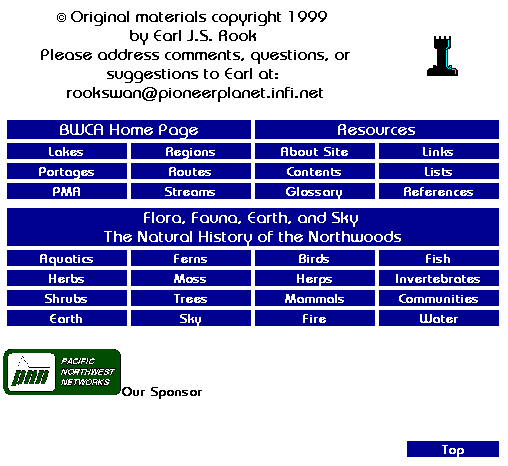Name:
|
- Osmerus, from the Greek, osme, "odor". Gives off an
odor likened to freshly cut cucumbers
- mordax, from the Latin, "biting"
- Common name from its shimmering colors in water, which disappear when removed
from the water
- Other common names include: American Smelt, Freshwater Smelt, Frost
Fish, Ice Fish, Leefish, Smelt
|
Taxonomy:
|
- Kingdom Animalia
- Phylum Chordata, animals with a spinal chord
- Subphylum Vertebrata, animals with a backbone
- Superclass Osteichthyes, bony fishes
- Class Actinopterygii, ray-finned and spiny rayed fishes
- Subclass Neopterygii
- Infraclass Teleostei
- Superorder Protacanthopterygii
- Order Osmeriformes, the argentines and smelts
- Suborder Osmeroidei
- Family Osmeridae, the smelts
- Genus Osmerus, the rainbow smelts
- Family Osmeridae contains 9 species in 6 genera in North America,
mostly Arctic or north temperate in distribution. Most are saltwater fishes.
Populations near the ocean are andromodus, but those in the midwest are
landlocked.
|
Description:
|
- A popular, introduced species of large waters
- Length
- typically 7"-9"
- can exceed 12"
- Weight 3 ounces
- Coloration
- silvery with pale green back
- iridescent purple, blue, and pink on sides
- white belly
- Body
- slender and cylindrical
- gill rakers long and slender, numbering 26-35
- dorsal fin of 8-11 rays
- anal fin of 12-16 rays
- pectoral fins of 11-14 rays
- pelvic fins of 8 rays
- has adipose fin
- tail fin deeply forked
- cycloid scales
- lateral line incomplete, with 62-72 scales
- Head
- elongated and pointed snout
- mouth large, with protruding lower jaw
- teeth on both mandibles
- Lifespan up to 8 years
|
Identification:
|
|
Distribution:
|
- Labrador to Virginia; also coastal Alaska.
- Introduced to Great Lakes, Mississippi River, and other inland waters
- Has been introduced into inland Minnesota lakes and is now found
in some large border lakes of the BWCA (Lac
La Croix, for example) and is likely to continue expanding its range
there.
|
Habitat:
|
- Near shore saltwater environments; also estuaries, inland lakes and streams.
- Sensitive to bright lights and warm temperatures; usually found in dark,
cool depths offshore. Optimum water temperatures 43º-56º F.
|
Food:
|
- Feed primarily on crustaceans and small fish, but also eat aquatic and
terrestrial insects.
|
History:
|
- Introduced to Michigan's inland waters as food for stocked salmon in 1912,
soon escaping to Lake Michigan, reaching Lake Superior by 1930.
- In the lower Great Lakes, rainbow smelt were at first regarded as a nuisance,
hordes of them invading and becoming entangled in fish nets.
- In Lake Superior, however, they were welcomed both as a forage fish and
as a recreational target during their spring spawning runs. Systematic
harvesting began in 1952, and dip-netting and seining in spawning streams
has developed into a popular, seasonal sport.
|
Uses:
|
- Processed for animal feeds but also enjoyed by people
- Spring smelt run has become a North Shore tradition
|
Reproduction:
|
- Spawns in spring, principally during darkness. Female can produce 12,000
to 50,000 eggs, which sink to the bottom and become attached to gravel
substrate by a short stalk formed from the outer shell membrane.
- Eggs hatch rapidly and larval young drift downstream to deep waters.
- Sexual maturity attained at 2 years of age.
|
Comments:
|
- This introduced species poses a potential threat to the fishes of
our northern lakes. Though a forage fish for larger species, such
as Walleye (Stizostedion vitreum)
and Lake Trout (Salvelinus namaycush),
it is a voracious feeder upon the young of these and other native fish.
|
Links:
|
|
|


Last updated on 6 November 1999
|